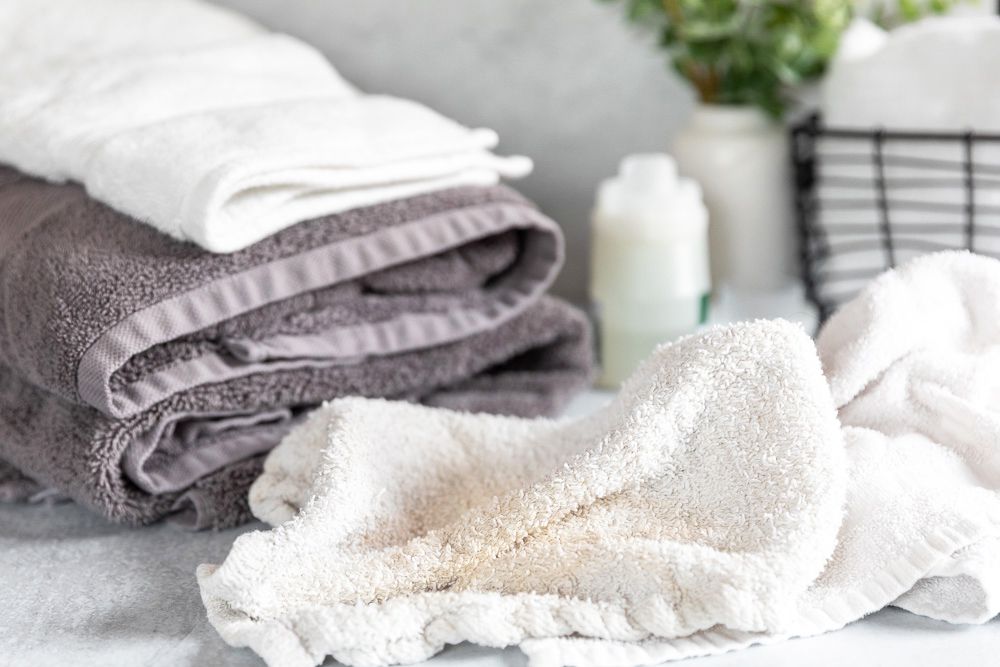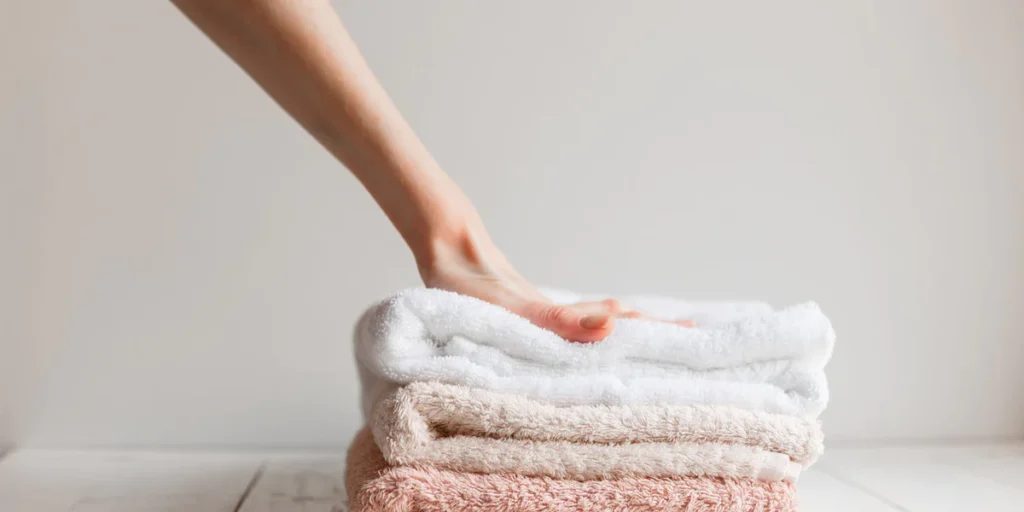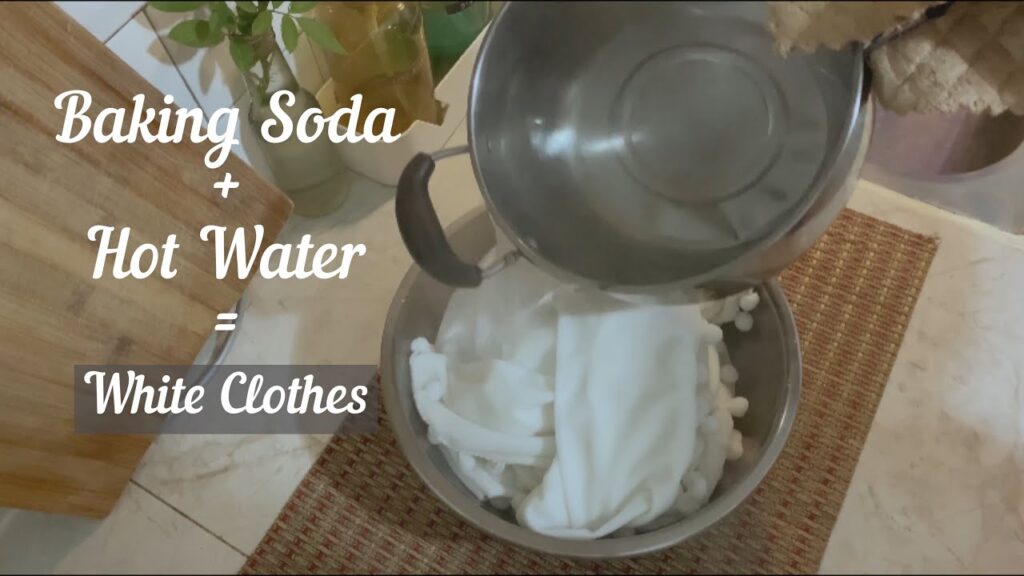Towels may eventually become yellow after bleaching. Bleach turns towels yellow as it contains strong chemicals that change towels’ real texture, and the water sometimes used on towels, if hard, also leads to discoloration of the towel. This topic will provide clear knowledge about towel discoloration.

Several things in the process of bleach turn towels yellow, such as:
Residue Buildup
Bleach and laundry detergent residues can react with water minerals and cause yellowing if they are not thoroughly rinsed off after washing.
Hard Water
Fabrics may have yellowish stains from the reaction of bleach and laundry detergents with hard water, which is high in minerals like iron and manganese.
Overuse of Bleach
Overuse of bleach turn towels yellow and weakens towel fibers. It is imperative that you adhere to the suggested usage guidelines located on the bleach container.
Ignoring Care recommendations
Certain towels may come with care recommendations that should be followed; failing to do so may cause discoloration. For instance, the color of the towels may be affected if hot water is used when the care instructions call for cold water.
Will bleach make my towels white again?
When it comes to bleaching towels and getting rid of stains, it works best when the discoloration is caused by mold, mildew, or specific kinds of stains.

To use bleach to whiten towels, follow these general instructions:
Examine Care Labels
Make sure your towels have care labels before using bleach. There may be particular instructions on certain towels on how to use bleach. Observe these guidelines to avoid causing harm to the cloth.
Dilute Bleach
Follow the directions on the bleach container to dilute any liquid bleach you may be using. Usually, you’ll combine a tiny quantity of bleach with water. It is never a good idea to directly apply undiluted bleach to the fabric, as this might weaken and destroy the fibers.
Pre-treat Stains
Before washing the entire towel, think about pre-treating any specific stains with a bleach solution if you have any. Before washing, directly apply the diluted bleach to the soiled area and let it sit for a short while.
Choose the Right Washing Machine Cycle
Depending on the fabric and care instructions of the towels, wash them in a washing machine on a regular or gentle cycle.
Rinse Well
To get rid of any remaining bleach, rinse the towels well after using bleach. Over time, residual bleach can cause damage to fabric fibers by weakening them.
Sunlight Exposure
You should think about hanging the towels in the sun to dry after you rinse them. Sunlight can intensify the whitening effect because it naturally possesses bleaching qualities.
When using bleach, it’s important to take safety precautions including wearing protective gloves and making sure there’s enough air. Furthermore, consider the possible effects of bleach on colored towel trims or patterns.
Always check that the bleach won’t have any negative effects on the towel by testing a tiny, discrete section of it first. If the materials that make up your towels are colored or delicate, you might want to think about using a different bleaching technique to prevent harm.
Why do my towels look dirty after washing?
If your towels still look unclean even after washing, there may be a few different causes.

These are a few typical causes:
Residue Buildup:
Towels become less absorbent and more likely to seem filthy as a result of the accumulation of detergent and fabric softener residues over time. Make sure you are using the appropriate quantity of detergent and refrain from using fabric softeners excessively.
Hard Water:
The minerals calcium and magnesium found in hard water can leave mineral deposits on towels, giving them a stained, drab appearance. If your water is hard, you might want to use a descaling agent or water softener.
Inadequate Rinsing:
Detergent residues might stick to towels after washing, giving them a dingy appearance. Make sure your washing machine is rinsing the towels thoroughly.
Overloading the Washing Machine:
When a washing machine is overloaded, towels may not get thoroughly cleaned. Make sure there is adequate room for the water and detergent to flow around the towels while they are being washed.
Old or Worn-Out Towels:
Towels have a finite lifespan and can lose some of their absorbency and increase their propensity to hold dirt. It may be time to replace your old or severely worn towels.
Combining Towels with Other Fabrics:
Steer clear of washing towels with materials like fleece or freshly cut denim that tend to gather a lot of lint. The towels may appear unclean due to the lint sticking to them.
Using Too Much Detergent:
Soap buildup on towels might result from using more detergent than is necessary. Observe the detergent usage instructions provided by the manufacturer.
Failure to Separate Colors
When light-colored towels are washed with dark-colored materials, color transfer may occur, giving the towels a soiled appearance. Sort your clothing according to color to avoid this problem.
To solve the issue:
Run an Empty Load
To clean the washing machine and get rid of residue, periodically run an empty load using hot water, vinegar, or baking soda.
Modify Detergent Usage
If your towels still appear unclean, use the suggested amount of detergent and maybe even less.
Examine the quality of your water
If it’s hard, you might want to use a descaling or water-softening solution.
Upgrade Towels
Investing in brand-new, high-quality towels can significantly improve the look and functionality of your worn-out, old towels.
Does baking soda whiten clothes?
Indeed, using baking soda to help whiten towels can work well. Baking soda is a helpful home ingredient for washing because of its inherent cleansing and deodorizing qualities.

To help whiten towels, try using baking soda as follows:
Add Baking Soda to the Wash
Baking soda can be added straight to your washing machine, in addition to your usual detergent. Utilize between half and cup of baking soda, contingent upon the size of the load. This may increase the detergent’s cleaning efficacy and result in cleaner towels.
Pre-Soak
You can make a paste by combining baking soda and a little amount of water for especially discolored or dirty towels. Before washing, apply this paste to the soiled areas and let it sit for a bit. This pre-soaking can aid in discoloration removal and fabric whitening.
In the Rinse Cycle
Adding baking soda to your washing machine’s rinse cycle can help remove residue, neutralize odors, and improve the brightness of your whites. It should be adequate to add around half a cup of baking soda during the rinse cycle.
Water Softening
Baking soda has the ability to soften water, which is especially helpful if your water is hard. Towels will be cleaner and brighter and your washing detergent will work better if the water is softer.
Always make sure your towels are safe to use with baking soda by reading the care labels on them. You should also always test a tiny, discrete area first to prevent any possible damage or discoloration. Furthermore, avoid immediately combining vinegar and baking soda in the washer since they could cancel out each other’s cleaning benefits.
want to buy towel click here